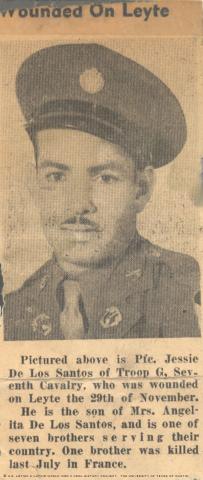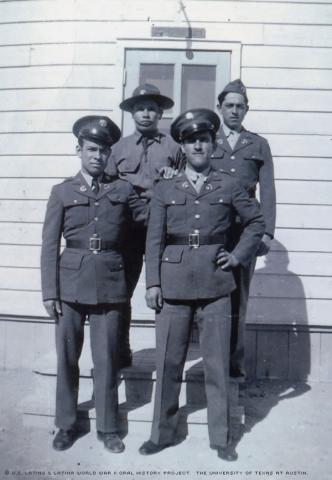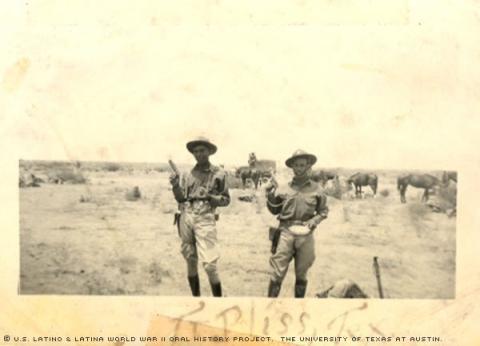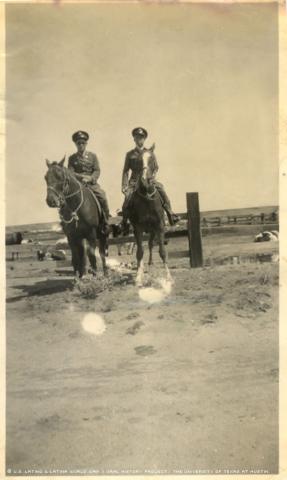



By Cheryl Smith Kemp
Number 10 in a brood of 16, Jesse De los Santos was well accustomed to being a mere piece of something much larger than himself by the time he joined the United States Calvary in 1939.
Little did he know, however, that in a couple of years he would be part of an event significantly bigger than the Calvary, the Army, all of the armed forces combined, even the U.S. itself. For on Dec. 7, 1941, the Japanese attacked Pearl Harbor and everything changed. World War II was on.
The Army’s 7th Calvary Regiment, of which De los Santos was a part, was stationed in El Paso, Texas, at Fort Bliss from 1918-1943. The regiment, whose members were called “Ruff Riders,” patrolled the Texas-Mexico border, as well as engaged in exercises in preparation for WWII during those later years.
According to Global Security.org, “In February 1943, the regiment turned in its horses and began retraining as foot soldiers for action in the Pacific Theater. Having moved to Australia in July 1943, the 7th conducted extensive amphibious and jungle training.”
De los Santos, or “De los,” as he says his fellow cavalrymen referred to him, is reluctant to talk about his WWII years; at one point, he almost starts crying when he tries. His Project Pre-Interview Form indicates he served on the New Guinea and Philippine Island battlefronts. He was discharged in 1945 at the rank of Sergeant, having acquired Malaria, as well as a bullet to the knee in the Philippines. Among other honors, he earned the Good Conduct Medal, Purple Heart and a Bronze Star.
“I didn’t want to leave friends there,” said De los Santos, of when he got sent home for good after getting shot in the right leg.
*********
Nicknamed “Chuy,” De los Santos was born on his family’s farm in Eastland, Texas, on March 15, 1920. When asked what his childhood was like, De los Santos, who went to school through the sixth grade, said: “working hard all the time, since we were little. … We had everything, until 1929. My father decided to go to Mexico.”
Raised in the city of Monclova in Coahuila, Mexico, De los Santos’ father, Ernesto De los Santos, had wanted to go back for years, De los Santos says, and the Great Depression gave him a good excuse. The De los Santos family only stayed there about six months, however.
“You think it was bad here in Texas. Out there, it was worse,” he said.
In sister Lita De los Santos’ unpublished memoir, “Memories of a Skinney Girl,” Lita describes the family’s foray into Mexico this way:
“Papa had one dream that he kept alive for a very long time[,] and that was to take the family back to his beloved Mexico and reclaim his proper heritage – his land – the land that his father had promised him. He felt that with his experience in farming[,] we would live a very beautiful and comfortable life. He yearned for his country and his roots[,] and one day decided to make his dream come true. With Mama’s sixteenth baby just born[,] Papa packed the family and we headed to his beloved Mexico.
“His dream came crashing down when we got there, for the lands he had dreamed of [were] no longer his or his family’s. The new government had taken the lands and given them out to the revolutionists. The lands had been parceled to all who would take and farm them. The De los Santos family had been disposed of their land and they had nothing. Those family members who had survived the war were now poor, struggling to survive the turn of events,” writes Lita, referring to the Mexican Revolution and the impact it had on her relatives.
So the De los Santos family started over on the Eastland farm, staying there until 1936 or 1937, until Ernesto, wife Angelita Guajardo De los Santos and the children moved to Colorado, where one of Angelita’s sisters lived.
“I didn’t like ranch work,” said De los Santos, who did love horses, and, as a result, soon joined the Calvary.
In her memoir, Lita describes De los Santos as “strutting around in his cowboy hat and boots. He was the only one in the family to own such grand attire[,] and where and how he attained them is a mystery to me. … I remember him riding off to town[,] sitting on a horse looking proud yet shy.”
Seven of De los Santos’ brothers followed his lead after WWII broke out: According to the De los Santos family, Ernesto served in the Air Force and was a Nazi POW; Candero, Pete, Belizarlo and Raymond served in the Army; and Nicolas and Eliseo served in the Navy.
“We all turned out good,” said De los Santos of his siblings.
After the war, he moved to Chicago, where Angelita had relocated after Ernesto died. In April of 1954, De los Santos married Mary Sandoval. They eventually had four children: two boys and two girls. He had five grandchildren at the time of his interview.
Like many people of his generation, De los Santos worked for the same company, Fulton Cold Storage, for 38 years. Although the Chicago freezer and cooler company paid well, his success isn’t the norm for Latinos like him, he says, referring to Hispanics who speak mostly Spanish.
“If you don’t know how to speak in English, it’s very hard here,” he said, following up that the work is often more difficult and lower paying in that case.
“Five or $6 an hour, no es nada,” he added, when asked if he has any advice for young Latinos.
Then, joking about being interviewed on his “day off,” the retiree asks if he can get paid for the session.
“Time and a half,” said De los Santos in Spanish with a laugh.
Mr. De los Santos was interviewed in Chicago, Illinois, on July 13, 2007, by Yazmin Lazcano.

